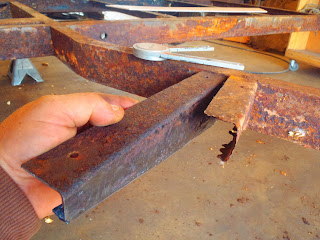Work progresses. The templates, made before the shell was lifted, were brought out.
The sheets were cut to size and also cut for Lamellos ("biscuits" to you non wood workers, or those younger wood workers. Lamello was the company that invented the plate joining system way back in the day and it was what it is called by the older cabinet makers. Now a days, everyone calls them biscuits. I ask for sausage gravy when I hear someone call it a biscuit.)
The Lamellos align the sheets and help strengthen the seam when they are glued together.
Here you see how the template comes into play. The outside of the curve is 1 3/8"beyond the template (verify your year with a tape measure. Years vary, factories vary, one days production varies from the next. Assume nothing) so I cut a 1 3/8" block and traced the cut line.
All the sheets were cut out and dry fitted into place.
The templates took all the guess work right out of this phase. I cannot emphasis the importance of making an accurate template. Enough said on this.
The floor was then pulled back off and the frame was treated.
We have a lot of things going on here with the frame treatment and painting;
The first thing I did was clean all the metal by sand blasting to remove the old paint, scale, and loose metal. The new metal was then cleaned using Marine Clean, then the entire thing was treated with Prep & Ready, then all parts that would not be seen were sprayed with two coats of the Rust-Preventative Paint.
Next all the metal parts that will be seen, were sprayed with two coats of epoxy primer. This is a two part primer. It is a super tough product that is designed to work as a system with the PPG auto paints I use. Mixture proportions and timing are extremely important with these types of finishes. The various stages literally bond together into a complete coating system.
Next, two coats of base were sprayed on. It is a silver metallic base coat. I am not a big fan of silver, but it was specifically requested. The photo never does the color justice. After the base coat dried 30 minutes, but no more than 4 hours, three coats of clear were sprayed on top of the base.
Here you see all the plywood glued together into one big sheet. Sorry there are no detailed images of that step. Long clamps and pinch dogs kept the sheets together while the glue set up. You may also notice that all the elevator bolts have been installed. Most of the channel has been bolted down also. Not in the images either is the layer of Reflectix on the underside of the subfloor.













































































